I was interested in the fact that the gallery had been set up with a Victorian philanthropic agenda much like the then current New Labour’s “Art for All”. I wanted to make my project about that legacy in the publicly funded art world of the late 90’s.

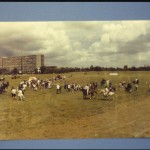
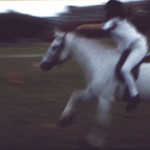






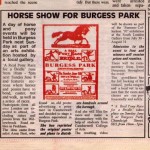
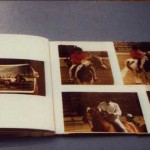
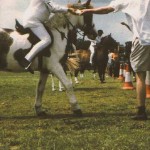

There was a group show “Summer Collection 1997” at the South London Gallery and the curators asked the artists to look at the Collection in the gallery, and make a piece of work in response. I found a nineteenth century poster advertising a pony race in a local park. As a reenactment of an event staged form that era, I decided to try and organise the “Real Pony Race” as a contemporary gymkhana. This process of production, the event ( people from local stables in Limehouse and Peckham, Dulwich and Isle of Dogs, a potato race and a doughnut race and a sack race and a competition for the best turned out pony and rosettes and a judge from the nearest pony club, a commentator) and its documentation all featured at different moments in time, as a potetnial work of art.
One of the motivations for this project was that there were stables in the backyard where I was living at the time, in a warehouse in Limehouse, and I had met and got to know the people who had ponies there. They were all young people, teenage boys with stallion ponies that they would ride around the backstreets, or just take out for walks. And as I was doing research and finding out how to organise the event and who might come to it, I then discovered this whole network of ‘underground’ stables in east and southeast London.
About 13 ponies and riders came in the end, from Dulwich, Peckham and Limehouse. It was in the middle of Burgess Park and the whole thing was pegged out at dawn and over and gone by the end of the day. There was also a battle of ice-cream vans. I got one to come along especially, one that was endorsed by the council, and then another cowboy van came along and tried to nick their pitch. This obviously sparked an interest in turf wars. Someone who I had been in contact with from Southwark Council decided to come along on the day with a bouncy castle and blew it up. I always loved the audacity of setting something up, setting an idea in motion, and then it taking on a life of its own because other people had got involved.
It was a typical mixture of weather, at one point there was a storm and everyone ran for cover, then it cleared and the sun came out again.
I had been working with a group of Camberwell Art School students, thanks to their tutor Angela Eames, and they got involved and helped me film and photograph the event. We tried to film in the same way they film proper horse racing, by hand with the college’s vhs cameras. The curators, also students, were the stewards on the racecourse. Some of the people who came from the pony world asked if I was going to do this again next year because it was good for their kids and I said to them, “No (way), but you could,” and tried to pass on information to them, such as who to contact at Southwark Council. This was a taste of things to come in terms of artist as facilitator, a role I always wholeheartedly refused to play – it was an ongoing misunderstanding between myself and commissioners. I invited the art audience to the pony race and then the pony audience to the gallery, so there was a cross-over. What was interesting to me was that quite a few people from the art audience didn’t come to the pony race because they didn’t realise it was an art event, then they kicked themselves. I remember someone else describing it as a pseudo-community event, but I was not thinking about how to include marginalised young people, for example. I felt that wasn’t what it was at all. It was a pony race for only those reasons that I found a poster in the SLG collection, and I was thinking about it in the same way as a ready-made, as a piece of conceptual art. I was just following instructions. I followed what you do to organise a pony race, I used my capacities as an organiser, and with a lot of other people’s help, put together the ingredients of a pony race into the formal structure of the event. A friend and tutor of mine from when I was at art school described it well I thought. Dave Carr Smith said – Anna it’s like you just opened a filing cabinet and the whole event exploded from 2 dimensions from the poster you found in there.
The project was represented in Summer Collection with the original poster in the frame, our video and a photo album, part of an installation which had a table where you could order any of the photos , so people from the pony world could look through and see which photos they wanted to order. In the end the whole work was bought by the South London Gallery and it’s now in their Archive/collection.
Date
1997
Media
Live event
Installation
Videos
Photographs
Aknowledgements
South London Gallery, London
Burgess Park, Walworth, London
Park Rangers
Camberwell College of Art – Angela Eames Drawing Course students: including Emily Druiff + Dimitri Launder.
Corinna Loges
David Cuffe Vetinary Surgeon
Goldsmith’s Curators: Heather Galbraith, Bettina Wilhelm, Marina Fokidis
Irene Benjamin commentary
Jimmy’s Community & Activity Centre
Kingston Riding Club
London Borough of Southwark Park Services
Mudchute Riding School
Mary and Isabel
Mission Place Stables
South London Gallery
South London Pony Club
St John’s Ambulance
Vauxhall City Farm
Wendy Hicks
Willowbrook Stables
Wimbledon Pony Club
Archive
- The South London Gallery Collection
- Video loop wide shot of Burgess Park
- Video of pony race (25 min)
- Scans of pages from photo album
- Scans of working notes
- C/u photos of pinboards
- Text by Anna Harding for Out Of Here
- Summer Collection
- https://www.southlondongallery.org/collection/anna-best-real-pony-race-bridle/
- SLG archive
- SLG archive
- SLG Archive
- http://www.southlondongallery.org
- Curator David Thorp worked with students from Anna Harding‘s Goldsmiths Curating Course.